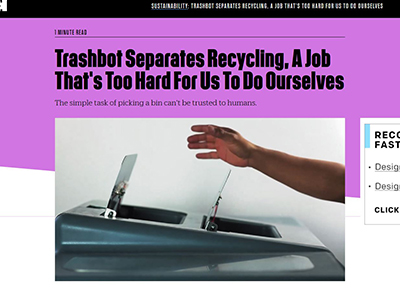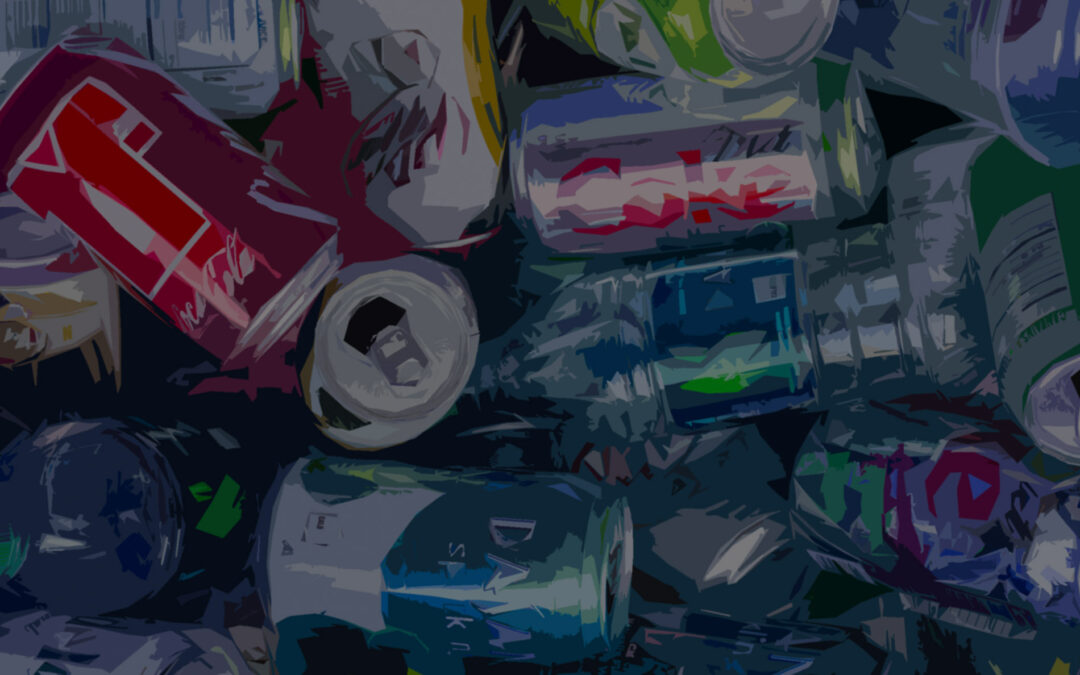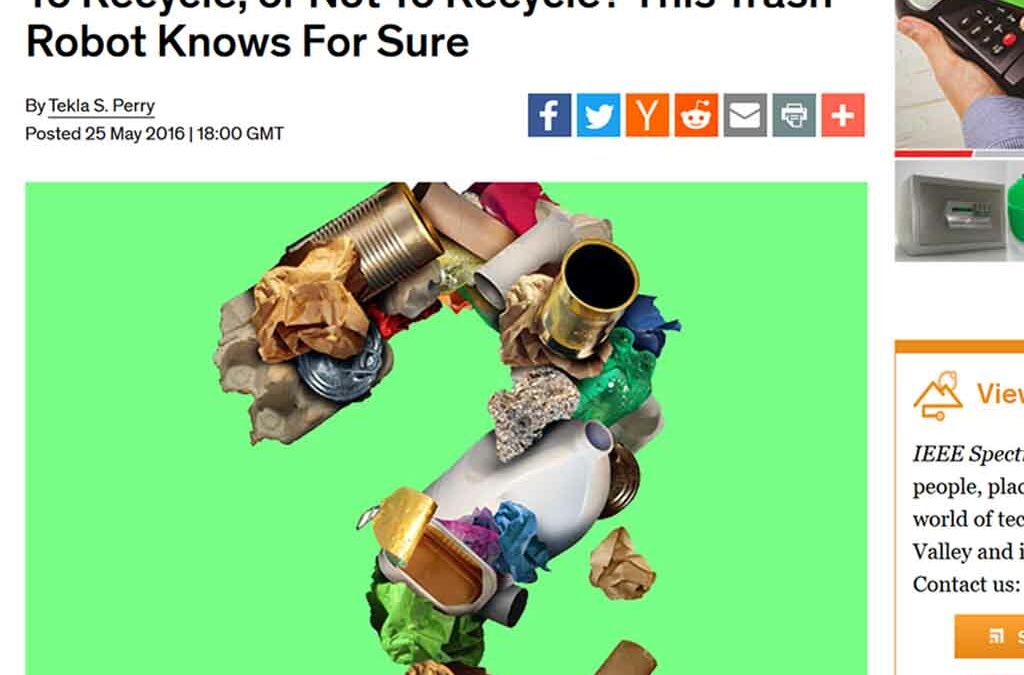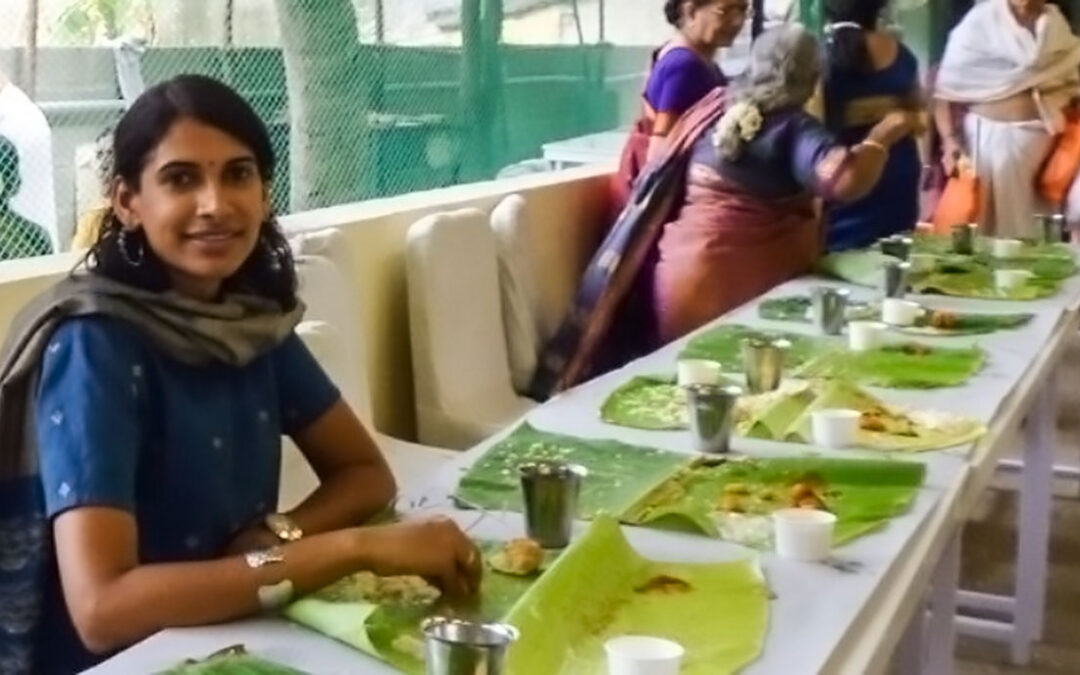
TrashBot Featured On Fast Company
Trashbot was featured on Fast Company. Read it here here.

Trashbot was featured on Fast Company. Read it here here.

Trashbot was featured on IEEE Spectrum. Read it here here.

CleanRobotics is looking for a VP of Engineering! Read more on our Career Opportunities page

Trashbot was featured on IEEE Spectrum. Read it here here.

At CleanRobotics, we believe that sustainability just plain makes sense from a business perspective. Customers all over the world, but especially millennials, are more likely to buy from businesses that show concern for the environment and sustainability. Consider these statistics:
Green initiatives go hand in hand with increased revenue, not just in the US but all over the globe as represented by these findings. In order to appeal to consumers with stronger preferences for being environmentally friendly, many companies are pursuing a zero waste policy.
What is zero waste? Zero Waste means designing and managing products and processes to systematically avoid and eliminate the volume and toxicity of waste and materials, conserve and recover all resources, and not burn or bury them. source: wikipedia.org.
Companies as diverse as Walmart, Subaru and Nestle are subscribing to zero waste. Walmart declares: “Our aspirational goal of achieving zero waste across our global operations is bold, but we continue to make measurable progress. In the U.S., more than 81% of the materials that flow through our stores, clubs, and distribution centers is being diverted from landfills. Our operations in Japan and the U.K. lead the way with a diversion rate of more than 90%, while Walmart Canada and Walmart Mexico divert more than 70%.”
Subaru lays claim to “becoming America’s first zero landfill auto maker”. Nestle USA last year achieved landfill-free status at all of its U.S.-based facilities.
At CleanRobotics, we support this process and are contributing to it with our smart TrashBot waste bins that can isolate recyclable materials from landfill waste. Imagine if your company did not have to rely on costly manual audits to keep track of your building waste…. If you were able to get a real time picture of your office and kitchen waste, you could be more proactive. You could understand the biggest drivers of waste and take steps to minimize or eliminate them! Your offices would be more attractive for millennial workers and your business could benefit from sustainable practices.Happy Earth month to everyone supporting sustainability and smarter recycling initiatives this month from us at CleanRobotics!
Zeynep Tolon is the Senior Marketing Strategist at CleanRobotics. At CleanRobotics, we are working to make recycling smarter. Join us and find out more at www.cleanrobotics.com

People often ask me “Why did you start CleanRobotics?” I have no real background or work experience in waste management or robotics (though technically, I am an electrical engineer by education). The short answer is that I am both fascinated and distraught by waste. Fascinated because weas humans, are able to buy, consume, and throw away so much stuff, but at the same time distraught by the terrible state of our waste disposal systems. If we spent as much time and effort disposing of an item as when we bought it, whether it is an article of clothing, a battery, or a plastic bottle, we would have a much cleaner earth. Just think about this for a second! We get such a kick out of buying that nice dress or making sure that battery is exactly what we need, but do we spend that same amount of time (or even a fraction of it) making sure it is going to the right place once we are finished with it? Unfortunately, the answer is no. It isn’t always practical and we lack the innovation and support in the disposal systems to make this happen. For the record, I personally get the same kick out of buying as making sure that I am disposing of things in the right place. I spend an inordinate amount of time researching where I should dispose our CDs or those umpteen cables that no longer work. We still own our stereo cassette player because I cannot imagine it ending up somewhere in a landfill. It works after all!
Why this attraction to waste? It is because of how I was raised. Growing up in India, my mother made sure that nothing went to waste in our house. Things were reused and recycled as much as possible. I was the 3rd child, a.k.a. the “hand-me-down” child. Until I became old enough to realize that I was wearing my brother’s shirts with my sister’s skirts, my mom got away with it. After we were done with our clothes, we donated them to the less fortunate or to orphanages. We didn’t have much in the way of electronics and I don’t know what happened to that first computer we bought or the floppy disks, but knowing my parents, I am sure that it was all donated to someone who would use it, though it agonizes me to think that it might now be in the landfill. The truth is the waste disposal systems and landfills in India (like many places) do not have the capacity to take in modern waste.
When it came to food waste, we truly had a zero waste system. At home, when there was leftover food, it was donated to the less fortunate. Beggars made rounds at night looking for food right after dinnertime; something that always made you feel grateful for the meal you just ate. Any other organic waste from the meal prep/cooking was thrown out on the street where our dear cows relished them! The cows ate our paper waste (like newspapers) as well. I don’t even remember having or needing a waste pickup in the late 1980’s.
When we went out for groceries, we always carried a bag of our own and Tupperware for getting take-outs. Let me say here that the Tupperware fights between women over containers lost or not returned on time was a big deal. Families split over this issue! When you bought dry goods like rice or lentils, the vendors wrapped them in newspaper (similar to the picture below) and sometimes used a rope made out of jute to secure it in place. The vendors were so adept and fast at it, it was like an art to watch. They were always happy to show off their skills to the waiting children and their impatient parents, too.
At large parties, weddings, and other special occasions, we ate on a banana leaf which is completely compostable (or made for a delicious meal for our cows). You can see me eating from the banana leaf at one such event in the picture on top. We used our hands (washed and cleaned, of course!) to eat so we didn’t have plastic forks and spoons to dispose. I could even eat soup out of a banana leaf with my hands, an art that is dead and the next generation will not know how.
Then came the introduction of plastics and other strange items that we didn’t know what to do with. In the 90’s, we started seeing plastics and strange waste items like biscuit and candy wrappers, laminated paper, our first computer, vacuum cleaner, TV, etc. This complicated the waste stream. We questioned what to do with it, but you do what everyone else does… you throw it on your neighbor’s property after dark (just kidding!) or out on the street. It created its own ecosystem. People made a living recovering stuff from trash that was still usable (like plastics, metals, etc.) and taking it to small buyers for a modest price.
Fast forward to today. I don’t know what is in half the stuff that comes through my front door. I shudder to think where those strollers or pack n’ plays go when they no longer work. I look around during our travels and every place on earth is grappling with the same issue–beaches, parks, highways–all are littered with trash. I remember reading Into Thin Air, a book by Jon Krakauer about the 1996 Mt. Everest disaster. The author talked about how disappointed he was when he climbed the legendary mountain only to see that there was trash everywhere. I remember thinking that I, too, had imagined this pristine, clean, white mountain and that it had never occurred to me that after so many people visiting and climbing Mt. Everest, it has become this trash land. Granted, trash probably was/is the last thing on a climber’s mind when it is a matter of life or death and I don’t blame them! If I had to worry about where I was going to throw away a power bar wrapper versus where to place my foot next (which if done incorrectly could take me down a bottomless crevasse), I think I would choose the latter as well! Thankfully, after Jon Krakauer’s assent, he started a movement to clean Mt. Everest by asking every climber to bring a bag of trash back down with them.
Someone much, much smarter than me once said “change can start anywhere.” It became clear that someone needed to do something about this planet’s problem with trash. The waste industry lacks innovation in comparison to other industries, so though I am but one tiny person without any background in waste management or robotics who used to feed her trash to the cows, I thought that perhaps I could try. I know that the statistics for success are not in my favor. Something like 0.001% of all startups succeed, but I could not live knowing that I didn’t try. So here I am, working on this mission, taking a chance with an amazing group of people who feel the same way, and in a wonderful city that is going to give me the best odds for success. Now, it is only a matter of hard work and advanced sensor technology. With some good luck, maybe I will help move that needle just a tiny bit towards a greener earth?
Happy Earth Month!
VaishVaish Krishnamurthy is the founder and CEO of CleanRobotics. At CleanRobotics, we are working to make recycling smarter. Join us and find out more at www.cleanrobotics.com